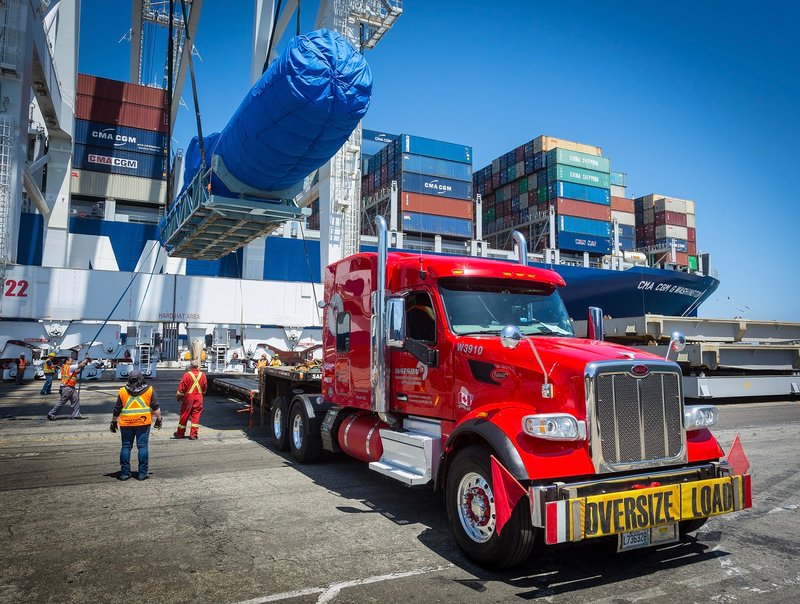 An aircraft part is offloaded at Pacific Container Terminal at the Port of Long Beach.
An aircraft part is offloaded at Pacific Container Terminal at the Port of Long Beach. Los Angeles, Long Beach Harbor Commissions to consider Clean Truck Rate
The Harbor Commissions from the ports of Los Angeles and Long Beach will both consider a resolution to approve a proposed Clean Truck Rate at upcoming board meetings. The Clean Truck Rate is expected to accelerate the introduction of cleaner drayage trucks into the port complex.
The Los Angeles Board of Harbor Commissioners will take up the Clean Truck Rate at its 9 a.m. meeting on Thursday, Feb. 20. The meeting will be held at the Port of Los Angeles Administration Building, 425 S. Palos Verdes St., San Pedro 90731. It will be available on livestream here.
The Long Beach Board of Harbor Commissioners will consider the Clean Truck Rate at its 1:30 p.m. meeting on Monday, Feb. 24. The meeting will be held in the Bob Foster Civic Chambers at Long Beach City Hall, 411 W. Ocean Blvd., Long Beach 90802. It will be available on livestream here.
The ports held an initial workshop on the clean truck rate on Aug. 1, 2019. A second workshop on the clean truck rate was held on Dec. 18, 2019 after the release of the Draft Economic Study. Additional discussion and comment on the rate occurred at the ports’ regular quarterly CAAP stakeholder meeting held on Jan. 15, 2020. Public comments were accepted through January 31st.
The Clean Air Action Plan (CAAP) has established a goal of zero-emissions for drayage trucks serving the ports by 2035. A key component of the overall strategy to transition to a zero-emissions truck fleet is the establishment of a Clean Truck Rate structure. After approval of a clean truck rate resolution by the Boards of both ports, the following actions must occur before the Ports will begin collecting the rate. First, the California Air Resources Board must set its ultra-low NOx engine emission standard. The California Air Resources Board anticipates that it will take action on its ultra-low NOx standard in spring 2020. Next, the Ports must establish a mechanism to collect the rate at the gates. The ports anticipate that this will occur also in spring 2020. Once those actions occur, the ports will present a tariff amendment to their respective Boards implementing the rate. The ports expect to begin collecting the rate in the latter half of 2020.
Updated in 2017, the CAAP contains a comprehensive strategy to accelerate progress toward a zero-emissions future while protecting and strengthening the ports’ competitive position in the global economy. Since 2005, port-related air pollution emissions in San Pedro Bay have dropped 87% for diesel particulate matter, 58% for NOx and 97% for sulfur oxides. Targets for reducing greenhouse gases (GHGs) from port-related sources were introduced as part of the 2017 CAAP Update. The document calls for the ports to reduce GHGs to 40% below 1990 levels by 2030 and 80% below 1990 levels by 2050. The CAAP was originally approved in 2006.
The Port of Los Angeles and Port of Long Beach are the two largest ports in the nation, first and second respectively, and combined are the ninth-largest port complex in the world. The two ports handle nearly 40% of the nation’s total containerized import traffic and 25% of its total exports. Trade that flows through the San Pedro Bay ports complex generates more than 3 million jobs nationwide.









